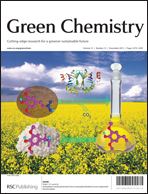Environmentally benign enhanced H2 production from abundant copious waste H2S using size tuneable cubic bismuth (Bi0) quantum dots–GeO2 glass photocatalyst under solar light†
Abstract
Hydrogen sulfide is a copious gas produced in refineries (15–20%) as well as billions of tons produced as a by-product in alkali industries. Selectively, only 5% has been utilised for the Claus process to produce liquid sulfur and it is also well known for its uneconomical and environmental problems. Here, we have demonstrated a significant green approach for conversion of poisonous H2S into H2 by stable cubic bismuth (Bi0) quantum dot–glass nanosystems using solar light as the energy source. Previously, metal oxides and sulfides have been demonstrated as solar light photocatalysts. However, a unique bismuth quantum dot–glass nanosystem has been designed where cubic phase bismuth quantum dots of size 1–2 nm are grown in the germanate glass matrix successfully. The presence of bismuth (Bi0) was confirmed by XRD, Raman, TEM and X-ray photoelectron spectroscopy (XPS). The glass nanosystem shows quantum confinement with variation of the band gap from 2.95–1.51 eV. Considering the broad absorption from visible to near IR, we used this glass nanosystem as a solar light active photocatalyst and hydrogen production with respect to the quantum confinement of bismuth (Bi0) quantum dots has been demonstrated for the first time. The photocatalytic activity for hydrogen production using glass nanosystems having bismuth quantum dot sizes of 1–2 nm and 3–6 nm was measured under solar light and prima fascia observations revealed that the glass nanosystems with very small quantum dots (1–2 nm) showed enhanced hydrogen evolution (11 541 μmol h−1 g−1) from H2S. The hydrogen evolution obtained is much higher than for previously reported visible light active nanostructured sulfide/oxide or embedded glass nanosystems. The glass nanosystems were also used for water splitting and show evolution of hydrogen without any co-catalyst. It is noteworthy that the quantum dot–glass photocatalyst is highly stable and catalyst regeneration is quite easy and fast. Hence, the QD-bismuth–glass nanocomposites have significant advantages over normal nanosized powder catalysts. Such unique glass nanosystems will also have great potential in photonics and optoelectronic applications.


 Please wait while we load your content...
Please wait while we load your content...